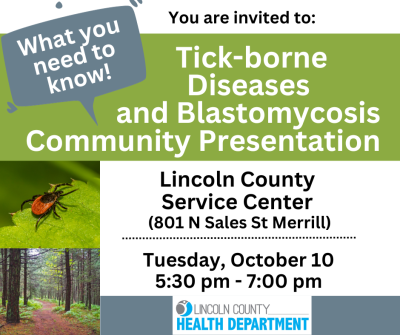
The Lincoln County Health Department (LCHD) held a Tick-borne Diseases and Blastomycosis (also known as Blasto) Community Presentation on Tuesday, October 10, 2023.
If you were unable to attend, click here to watch the recording!
Below you will find handouts from the event.
During the recorded presentation, you will learn more about these diseases from presenters from the Wisconsin Department of Health Services (DHS), Aspirus Tick-borne Clinic of Woodruff, and LCHD. Education was shared on the signs and symptoms, treatment options and the latest local data trends on tick-borne diseases and Blastomycosis. If you have any questions, please reach out to Lexi Buntrock, Public Health Educator, at 715-539-1374 or lexi.buntrock [at] co.lincoln.wi.us.
Lincoln County has historically had a higher rate of tick-borne diseases and Blastomycosis than other areas in Wisconsin. It is important that all residents are educated on the signs and symptoms of both of these diseases and seek medical attention in a timely manner.
Tick-borne Illnesses
There are several different types of tick-borne diseases we see here in Lincoln County, including, Lyme disease, anaplasmosis, ehrlichiosis, and babesiosis. In 2022 alone, there were 91 reported tick-borne disease cases, leaving many residents ill. According to Rebecca Osborn, Vectorborne Disease Epidemiologist for DHS, “Thousands of Wisconsinites each year will be diagnosed with a tick-borne disease. Knowing more about how to prevent these diseases and when to seek treatment can help keep you and your family stay healthy and active.”
View handouts from the Aspirus Tick-Borne Illness Center below under Supporting Documents.
Blastomycosis
From 2013-2022, there were 40 cases of Blastomycosis reported in Lincoln County. Of those, 52.5% (21/40) resulted in hospitalizations, some of which unfortunately resulted in death. Symptoms of Blastomycosis can mimic influenza, acute bacterial pneumonia or other lung infections. This can make diagnosis difficult.
